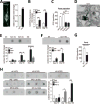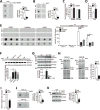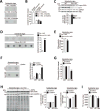Dopamine oxidation mediates mitochondrial and lysosomal dysfunction in Parkinson's disease
- PMID: 28882997
- PMCID: PMC6021018
- DOI: 10.1126/science.aam9080
Dopamine oxidation mediates mitochondrial and lysosomal dysfunction in Parkinson's disease
Abstract
Mitochondrial and lysosomal dysfunction have been implicated in substantia nigra dopaminergic neurodegeneration in Parkinson's disease (PD), but how these pathways are linked in human neurons remains unclear. Here we studied dopaminergic neurons derived from patients with idiopathic and familial PD. We identified a time-dependent pathological cascade beginning with mitochondrial oxidant stress leading to oxidized dopamine accumulation and ultimately resulting in reduced glucocerebrosidase enzymatic activity, lysosomal dysfunction, and α-synuclein accumulation. This toxic cascade was observed in human, but not in mouse, PD neurons at least in part because of species-specific differences in dopamine metabolism. Increasing dopamine synthesis or α-synuclein amounts in mouse midbrain neurons recapitulated pathological phenotypes observed in human neurons. Thus, dopamine oxidation represents an important link between mitochondrial and lysosomal dysfunction in PD pathogenesis.
Copyright © 2017 The Authors, some rights reserved; exclusive licensee American Association for the Advancement of Science. No claim to original U.S. Government Works.
Figures





Comment in
-
Dopamine oxidation mediates a time-dependent pathological cascade in Parkinson's disease.Mov Disord. 2018 Feb;33(2):250. doi: 10.1002/mds.27262. Epub 2017 Nov 23. Mov Disord. 2018. PMID: 29168581 No abstract available.
-
A Peek into Parkinson's Disease Progression through Human Dopamine Neurons in a Dish.Trends Neurosci. 2018 Feb;41(2):74-76. doi: 10.1016/j.tins.2017.12.001. Epub 2017 Dec 14. Trends Neurosci. 2018. PMID: 29248177
References
Publication types
MeSH terms
Substances
Grants and funding
LinkOut - more resources
Full Text Sources
Other Literature Sources
Medical
Molecular Biology Databases
Miscellaneous

